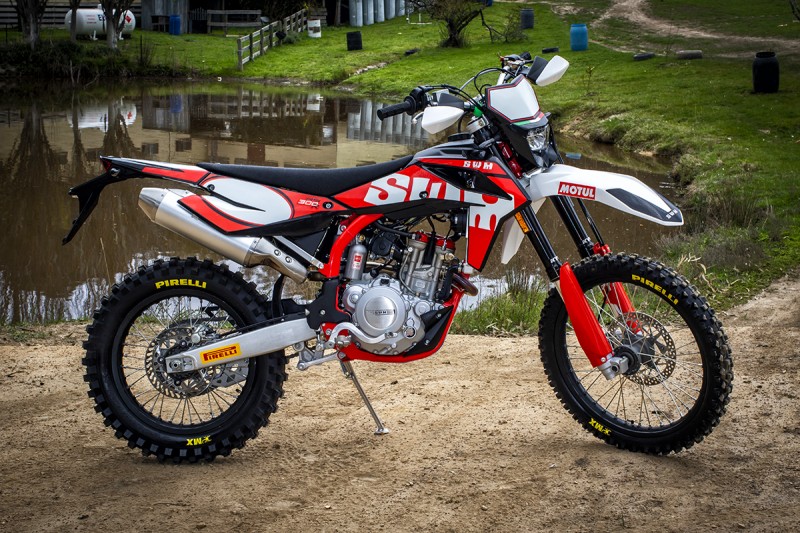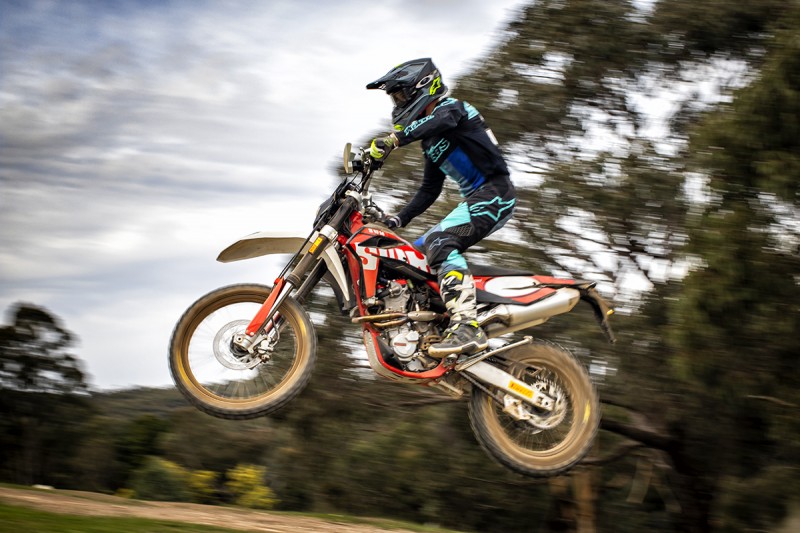

The SWM RS300R and SWM RS500R are two of the most important bikes on the market right now and yet they aren’t the most powerful. They don’t have the best suspension. They’re heavier than much of the competition. They will almost certainly never win a race, and the reason they are important is because they were never designed to win a race. You dig?
LOOK FAMILIAR?
We have race bikes coming out our ears at the moment. Old trail favourites have either become hardened weapons or are in danger of being wiped out thanks to the EU emissions legislation. We will have much less choice fairly soon and nobody seems to be in a rush to replace the trailbikes that serve as reliable servants for years and a great intro to the sport.
The SWM RS300R and RS500R are trail bikes in the purest sense. Ironically they’re built off a base that circa 2010 was touted as the cutting edge in enduro performance in the Husqvarna TE310 and TE510. I remember the hype around those Huskys so well and in fact I owned an ‘09 TE450. They were supposed to be hot snot but they ended up being a cold booger on paper plate.
Much of the frustration centred around the EFI mapping, the early Marzocchi forks which were as reliable as a chocolate kettle, and pros like Chris Hollis went through frames like I plough through meatloaf. We know now that Husky had bitten off more than it could chew and over-reached dramatically. The pre-KTM run ended with the TE310 which was probably the best bike they had produced for years (the WR250 was a cracker too), but it was too late and the subsequent Austrian invasion morphed the brand into a clone.

KITTED-OUT
So now the bikes are back under the guise of SWM, an iconic Italian moniker reborn with the backing of the Italians and the Chinese and with access to one of the most impressive factories thanks to BMW’s investment when it owned Husky. The engineers are largely ex-Husqvarna and the company is looking to make small but steady strides year-on-year in an effort to grow.
We recently rode the 2019 RS300R and RS500R and found the new focus on value and rideablity to be totally refreshing. This ewasnt about lap times or clearing triples; it was just about trail riding on a bike built to make that as fun and easy as possible
The 2019s have new plastics and graphics as well as new EFI mapping, new seats and subframe and LED blinkers and headlight. As was on the first iteration of the SWMs the bikes have a hydraulic clutch, Brembo brakes and Kayaba suspension. There’s really not much to add to roll off the dealers floor and hit the bush.
The key start is a nice nod to its dual-sport suitability as is the high gearing – which is a little too high for dedicated bush work but a decent compromise for commuting mid-week and bush bashing on the weekend.
The dual pipes are quiet but the engine note is still fairly meaty.
The RS500R has a great engine that has maintained most everything that we loved about the TE510 donk in 2010. As I mentioned, it’s geared high but that mid-to-top is usable, fun and crazy-balls fast if you crank the right wrist. While it has some serious push, it’s predictable and still well and truly able to scare the shit out of you without being overly intimidating like a 500 EXC-F can be.
The RS300R engine is far milder as you’d expect. It really is an engine that would suit a broad range of riders and not just beginners. You could imagine that it sits somewhere between the TT-R250 and the DR-Z400 which is a pretty sweet spot for straight trail riding in that it’s not fatiguing but it still spins-up enough to get the pace up quickly, and in fact you can ride the 300 pretty fast, very easily. It is the better of the two models in the handling department with a more planted and steady front-end feel. The 500 is stable on straight line runs but suffers in corners were it pushes and fidgets at speed. I didn’t mess with the clickers at all on either but the Kayaba suspension is so compliant and forgiving and old-school plush that it kind of stirred something in me that longed for the days with an emphasis on more on fun and less on winning.
We rode fast trails and single trails with some decent hills in between and in my opinion the 500 is a lot of fun but the 300 is the better overall bike. I’d gear it down a little and have no problem trailriding it weekend after weekend. At times I found both bikes a little stubborn to start which reminded me well of my TE450 but other than that they were a pleasure to ride all day and I felt way less beat-up than if I’d got off a WR-F or EXC-F.
To top all this off, the RS300R retails for $8,290 and the RS500R will sell for $8,990 which is excellent value for money given some of the on-board standard equipment.
If you’re after a pure trail ride then check out the SWMs and if you’re super keen on price then have a look at the run-out deals on the 2018s. We personally prefer the 2019’s largely thanks to the EFI mapping updates but it’s likely that this will be made available through dealers for all existing models as well.

SPEC CHECK
SWM RS 300R
Engine: Liquid-cooled DOHC 4-valve single cylinder four-stoke
Capacity: 297.6cc
Bore x Stroke: 83 x 55mm
Transmission: 6-speed
Clutch: Wet multi-plate with hydraulic control
Ignition: GET
Fuel system: Mikuni D42 EFI
Start: Electric
Front suspension: 48mm USD Kayaba fork
Rear suspension: Kayaba shock
Front wheel: 21-inch with 260mm brake disc
Rear wheel: 18-inch with 240mm brake disc
Seat Height: 963mm
Wheel base: 1495mm
Fuel capacity: 7.2-litres
Weight: 107kg
SWM RS 500R
Engine: Liquid-cooled DOHC 4-valve single cylinder four-stoke
Capacity: 501cc
Bore x Stroke: 97 x 67.8mm
Transmission: 6-speed
Clutch: Wet multi-plate with hydraulic control
Ignition: GET
Fuel system: Mikuni D42 EFI
Start: Electric
Front suspension: 48mm USD Kayaba fork
Rear suspension: Kayaba shock
Front wheel: 21-inch with 260mm brake disc
Rear wheel: 18-inch with 240mm brake disc
Seat Height: 963mm
Wheel base: 1495mm
Ground clearance: 250mm
Fuel capacity: 7.2-litres
Weight: 112kg


